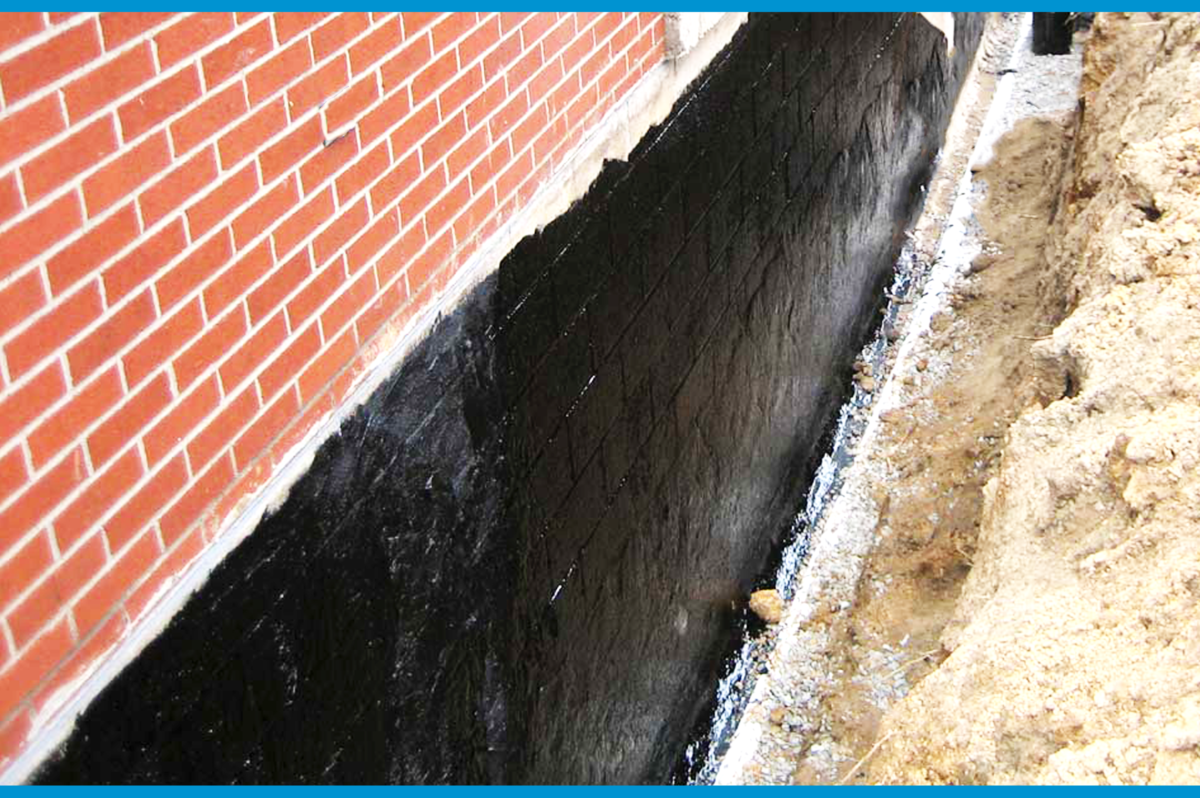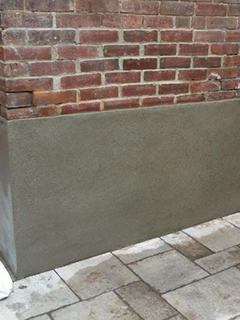What Is Foundation Waterproofing?
Many clients inquire about the process involved to complete foundation waterproofing.
The first step is to define what the purpose of the activity is. Simply put; foundation waterproofing involves the prevention of groundwater/moisture, penetrating through a building’s foundation walls, which can result in damage to interior spaces below grade (such as basements), and preventing the avoidable deterioration of the foundation structure itself.
Further consequences of water ingress through foundation walls can result in mould, mildew, efflorescence and damage to interior finishes. The items noted can also serve as clues to the fact that foundation waterproofing is a required action.
In eastern Canada and the U.S., most homes and commercial structures are constructed with basement areas, defined by poured concrete walls, or masonry block walls. In some instances, the foundation walls protrude above grade from six inches to three feet, depending on the structure; with a minimum of eight feet below grade.
Many older homes constructed in the eighteen hundreds and earlier parts of the nineteen hundreds may have shallow basement heights. Such older structures may also have rubble stone basement foundation walls or fieldstone basement walls.
As a result, there can be varied techniques required to achieve sound basement waterproofing based on the foundation circumstances of a particular structure. To add further complexity; in many downtown urban areas, homes have been constructed in very close proximity to one another, which can serve to make digging or excavating foundation walls difficult between neighbouring buildings.
While the majority of suburban homes have relatively good access to complete foundation waterproofing from the exterior, some urban homes have no choice but to complete waterproofing techniques from the interior of the basement area.
The process of waterproofing begins with the action of obtaining service locates involving gas, water hydro or cable, which has been located below grade. Failing this step can have dangerous consequences particularly where hidden gas lines may be concerned.
Once the utility locates are completed by the utility provider’s designate company, removal of dirt and or clay against the foundation walls can begin. In tight locations; the ground dirt may have to be stored in disposal containers or elsewhere at the site if there is limited room to store such material.
Trenches adjacent to the foundation walls are usually dug out to be about four feet wide, and dug down to the footing level of the structure. If only waterproofing one side of a particular structure, it is typically necessary to dig somewhat around each opposing corner in order to make a proper weeping tile connection to such sides.
When trenching, it is important to insure that proper shoring of the trench is completed to insure workers are not injured due to caving in of the trench.
Once the exposed exterior surface of the foundation wall is revealed, the next steps involve cleaning and properly preparing the surface.
Cleaning involves wire brushing down the foundation wall surface and may require power washing to remove all loose debris and dirt. Repairs, as required to the surface of walls, can now be completed.
In the case of a block wall foundation, tuck-pointing of deficient mortar joints may be required, where voids in the mortar may need to be repacked with fresh mortar. Poured concrete walls which exhibit cracks or divets in the surface, must also receive remedial cement repairs to insure the structure is sound. Hydraulic cement is typically used to fill cracks and voids.
Installation of a trowel applied cement parging serves to create a clean and smooth surface to accept future waterproofing materials. Such cement parging mix will contain a liquid concrete bonding agent to help achieve superior adhesion to the existing block or poured concrete surface.
Once allowed to properly dry and cure, the application of waterproofing materials can begin. There is an array of products available on the market which can be used as waterproofing agents.
Popular are liquid applied foundation coatings having an asphalt base. Other options include bituminous coatings. Such materials are commonly trowel applied with some versions being sprayer applied.
Common practice involves applying a poly sheeting over the liquid applied waterproofing materials. Alternative upgrades include the use of self adhering membranes, which provide enhanced waterproofing characteristics.
There are dimpled plastic sheets which can be mechanically attached over the waterproofing membrane(s), which serve to supply further protection and isolation of exterior earth from the foundation wall.
At the footing level, new plastic weeper pipe, covered in a filter cloth sheathing, is connected from corner to corner of the foundation and is set in crushed gravel, to a prescribed depth, before being filled back in with the former soil.
It is often necessary to add more soil and compact the area. Final grading involves shedding the dirt away from the foundation wall at grade; in order to promote positive drainage.
Where recessed window wells may be present below grade; such areas also should be comprehensively waterproofed, as they represent a common failure point. Installing a shedding plastic cover over such window wells also helps to divert water away from the area.
Other considerations of the project may involve the re-routing of downpipes away from the foundation wall at least five feet at ground level or re-connecting downpipes into below grade pipes where applicable.
Further cost considerations of engaging in such a project can include the restoration of sod, shrubbery, and landscaping, or hardscaping materials such as stone or concrete walkways.
A well done exterior waterproofing project should provide at least twenty years of life, and likely beyond. Costs involved to complete such work can vary greatly depending on the terrain, accessibility, and methodology required.
Where interior waterproofing of foundation walls is required; it is typically necessary to break the concrete basement floor adjacent to the wall and install weeper drainage pipes leading to the main drain in order to divert groundwater. Interior wall surfaces would require waterproofing to prevent water from leaching through. Such work can be unique to each particular home’s circumstance.
In some instances, the interior basement walls may require pinning from the interior if there is evidence of shifting.
Other methodology involves having an internal weeper tile system directed to a sump pump and sump pit located in the basement floor to direct water back out of the house.
It is best to have a professional waterproofing contractor survey the situation and in some instances, retaining an engineer is advisable to develop a strategy for interior basement waterproofing. The reason is that considerations involving electrical, plumbing, and internal furnace locations can add complexity on what specifically may be required in the overall scope of work.
Where stone basement foundations are concerned, it is important to note that stone can be porous, and often the integrity of such foundations is reliant on the integrity of the cement holding the stones together. When the concrete mortar breaks down, water can easily enter.
Some solutions involve repairing deficient mortar, and parging exterior and or interior surfaces, before applying waterproofing materials. Other solutions can involve pouring new exterior footings and forming a new exterior foundation wall; particularly if the existing stone foundation has shifted or exhibits any lack of structural integrity.
Commensurate with certain newer construction methodology, many homes are built using insulated concrete forms where concrete is poured into the forms (similar in nature to building blocks). Such methods provide higher thermal efficiency, and as such require alternative products to be used to waterproof the exterior foundation. Frequently specified is some form of membranes or liquid applied rubber coatings.
To learn more about foundation waterproofing, masonry, stonework, or other related services, visit www.avenueroadmasonry.com or see us on Youtube™.


